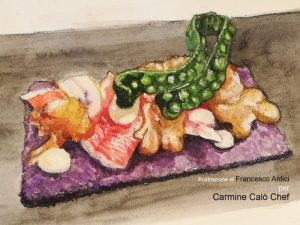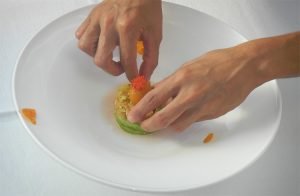Blog
A trip in the world of catering
Deep red colour, a crispy texture and an aroma that brings you back to summer and the countryside.
We are talking about ‘His Majesty’ the tomato,
the undisputed star of, not only, Italian tables. You can eat it fresh, or cooked and turned into sauce. It always maintains its enviable title of basic food of our Mediterranean diet.
You may not know that tomatoes are the most widely grown vegetables in the world after the potato and it is therefore difficult to believe that they were originally considered as poisonous and only used as ornamental plants. Native to South America, this plant was introduced to Europe by the Spanish in the sixteenth century and since then, its growth in popularity has been exponential.
Today, this vegetable comes in hundreds of different varieties, from the very small cherry tomatoes to the big beef tomatoes, from the traditional deep red colour, to yellow, green and even black tomatoes.
Its qualities are also countless: tomatoes are mainly made up of water and are characterized by an insignificant amount of fats, resulting in a very low number of calories (18 calories per 100 grams). They are a source of precious nutrients, above all potassium, phosphorus, vitamin C, vitamin K and folates.
The presence of lycopene is also very important: it is an antioxidant carotenoid which gives the red colour to tomatoes and other vegetables, such as the watermelon and the red fruits.
Mainly present in the skin, it has antioxidant and anti-inflammatory properties valuable in the fight against cell ageing and cancer.
THE BEST TOMATO
Both star decorated chefs and simple consumers still think that the best variety of tomato is grown in Italy, in particular in Campania, in the Valle del Sarno, at the foot of Vesuvius.
You can guess who we are talking about: the San Marzano, one of the most famous varieties in the world. As they say in Naples: “The San Marzano is completely different from all the other tomatoes”.
The unique values of this plain and this country plays a pivotal role for such a variety: the deep and soft ashes of the volcano are reworked by water, become stratified and enriched with calcium carbonate. This specific climate, Mediterranean and damp at the same time, results in a fertility balance which could not be replicated in any other places in the world.
The result is a tomato with a delicate pulp, a full-rounded flavour and a lovely sharp hint. In addition to this, the skin can be easily removed, there are just a few seeds and it can be used for slow cooking which turns the sourness into a sweet taste. In short, a real delicacy.
That’s why we decided to use it, together with two other varieties, the yellow tomato and the siccagno tomato, to prepare a new vegetarian dish, ideal for summer days.
Of course, waveco® plays a central role, because its innovative technology will allow you to reach an excellent maturation of tomatoes, making them even softer and taster, without any waste. You will even be able to use tomato skins, rich in antioxidant nutrients, and thus give the plate a touch of crunchiness that will ensure a surprise effect for diners.
OUR VEGETERIAN-VEGAN DISH
“Tomato, bread and basil”
Ingredients for 2 people
PROCEDURE
Put tomatoes in separate containers without spices. Add just a few basil leaves in the pouch with the San Marzano. After that, immerse the three envelopes inside the waveco® tank and start the induced maturation process. They will be ready in 30 minutes.
Think about the San Marzano: thanks to “Natural Improvement” by waveco® you can obtain a really soft product, almost homogenized. Simply filter it with a strainer to have a tomato sauce with a unique flavour. All the San Marzano delicate essence stays in the liquid and this is obtained in very little time compared to the traditional procedure.

At this point, you can focus on the siccagno green tomato: after the waveco® treatment, you are able to remove the skin very easily. Once cut in half, extract the whole pulp and put it into a bowl. Cut the rest of its shell into julienne strips: using the induced maturation process, tomato slices result to be extremely soft and juicy.
Add toasted wholemeal bread, oil, salt and basil to the bowl to make a crunchy raw panzanella: with waveco® you can obtain an extremely natural and fresh mixture that maintained all its organoleptic properties.
Let’s move on to the yellow cherry tomatoes. In this case as well, induced maturation allows you to peel them without any problems. Look at the food colour: using waveco® you can keep the natural aspect of the tomato without any sign of oxidation.
Once you have put the skin of the cherry tomatoes in a little bowl, dry it out in the oven at 40° for 30 minutes.

THE PLATE
Take a flat plate: place a first layer of slices of green tomato in the middle, then add the bread and tomato salad (panzanella) and a yellow tomato on top.
Pour in the tomato water at the bottom and finally garnish the plate with dried raw tomato skins. It’s so delicious for both the eye and the mouth.